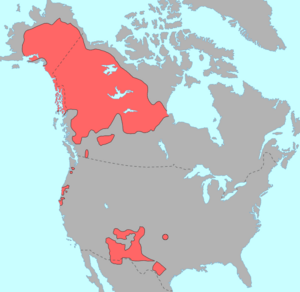Dismal River culture facts for kids
| Geographical range | Colorado, Kansas, Nebraska, South Dakota. |
|---|---|
| Period | Post-Archaic |
| Dates | AD 1650-1750 |
| Type site | Lovitt Site in Dismal River area of Nebraska |
| Major sites | Scott County State Park (Kansas) |
| Preceded by | Archaic |
The Dismal River culture was a group of people who lived in parts of North America between 1650 and 1750 A.D. Archaeologists first found signs of this culture in the Dismal River area of Nebraska in the 1930s.
This culture was different from other groups living on the Great Plains at that time. Many experts believe the Dismal River people spoke an Athabascan language. They are thought to be related to the people we now know as the Apaches.
Where They Lived
Signs of the Dismal River culture have been found in Nebraska, Kansas, Colorado, and South Dakota. In Nebraska, 18 sites were discovered in the Sand Hills region.
Some important places where their history was found include:
- The Lovett Site in southwestern Nebraska, which was the first Dismal River location found.
- An archaeological site at Scott County State Park in Kansas. This site helped connect the Plains Apache people to the Dismal River culture.
Other ancient village cultures in the Western Plains included the Antelope Creek Phase, Apishapa culture, Purgatoire Phase, and Upper Purgatoire complex.
The Apache Connection
The Apache people are descendants of the Athapascan people. These ancestors traveled into North America through what is now Alaska and northwestern Canada.
There are two main ideas about how the Apache ancestors reached the Plains and southwestern United States. They might have traveled through mountains, staying in a climate they knew. Or, they might have moved across the open plains. Today, the Navajo and Apache still speak Athabaskan languages.
The Apache groups most linked to the Dismal River culture are the Paloma and Quartelejo (also called Cuartelejo) Apache. Pottery from the Jicarilla Apache has also been found at some Dismal River sites.
Some Dismal River people later joined the Kiowa in the Black Hills of South Dakota. They became known as the Kiowa-Apache or Plains Apache. In the early 1800s, they moved south to Texas and Oklahoma. Most of the Dismal River people moved south in the early 1700s. This was because of pressure from the Comanche from the west and the Pawnee and French from the east. They later joined the Lipan Apache and Jicarilla Apache nations.
No sites have been found yet from the time when the Southern Athabaskans were nomadic (meaning they moved around a lot), starting around 1500 A.D.
Their Homes
Dismal River villages usually had 15 to 20 buildings. They were often built near streams. Their homes were round, like hogans, and were about 25 feet (7.6 meters) wide. They were built slightly underground or on flat ground. Wooden posts supported the structures, which were covered with animal hides or other materials. In the middle of their homes, they had hearths for fires.
Villages also had bell-shaped pits used for baking. These pits sometimes contained evidence of past activities.
Their Way of Life
The people of the Dismal River culture were skilled hunters. They mainly hunted bison. For hunting, they used small stone points for their arrows or spears. These points were often triangular or had small notches on the sides.
They also grew some of their own food, like corn and squash. They gathered wild foods too, such as nuts and berries. For tools, they used stones and bones.
They were known for their unique pottery, called Dismal River pottery. This pottery was usually gray-black. Many pieces were plain bowls. However, they also made ollas, which are large jars. These jars sometimes had simple stamped designs and decorated rims.
Meeting Europeans
In October 1719, the Spanish governor of New Mexico, Antonio Valverde y Cosio, traveled onto the Great Plains. He was looking for Comanche and Ute Indians who were raiding Spanish settlements. Valverde did not find the Comanche. But he met the El Cuartelejo Apaches (who were Dismal River people) near the Arkansas River in what is now eastern Colorado.
The Cuartelejo people told him that the French were giving guns to the Pawnee and "Jumano" (Wichita) people to their east. Valverde did not say much about the Cuartelejo. But he did mention that they moved their goods using dogs, which suggests they did not have horses yet.
In October 1724, a French explorer named Étienne de Veniard, Sieur de Bourgmont, visited the Dismal River people. He found them at a camp in Central Kansas, likely near Salina. Bourgmont called these people "Padoucas." When he arrived, 80 men on horseback met him. This shows that some Dismal River people had horses by this time.
Bourgmont described the camp as having over 4,000 people. He said they lived in large homes, with about 30 people in each. The population might have been larger than usual because other villagers came to meet Bourgmont. His description of large homes is different from what archaeologists have found. Bourgmont gave gifts to the people, including a few guns. The Padouca had never seen so many European goods and were scared of the guns.
Bourgmont wrote that the Padouca had permanent villages. They sent out hunting groups of 50 to 100 families. As one group returned, another would leave, so the village was always occupied. They traveled up to five or six days from their village to hunt. The Padouca grew corn and pumpkins. They traded with the Spanish in New Mexico for tobacco and horses, in exchange for tanned buffalo skins. The explorer noticed that some Apache still used flint knives for skinning buffalo and cutting trees. This showed that not many European goods had reached them yet.
Within a few years after Bourgmont's visit, the Padouca or Dismal River people he met in Kansas were gone. They had been pushed south by the Comanche.


